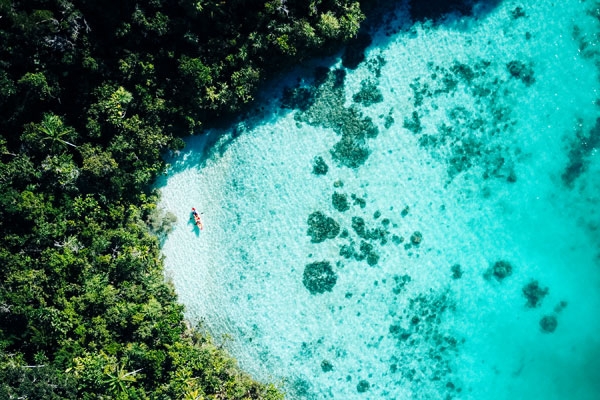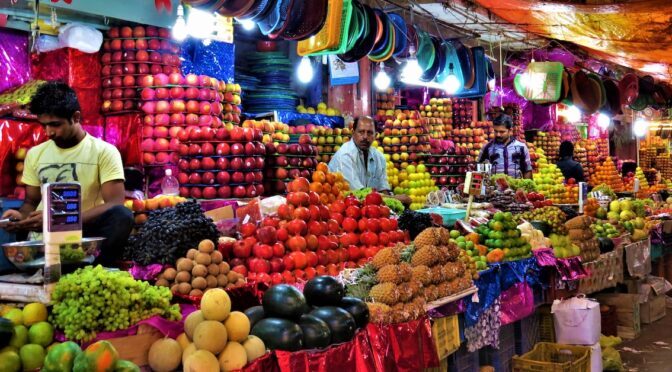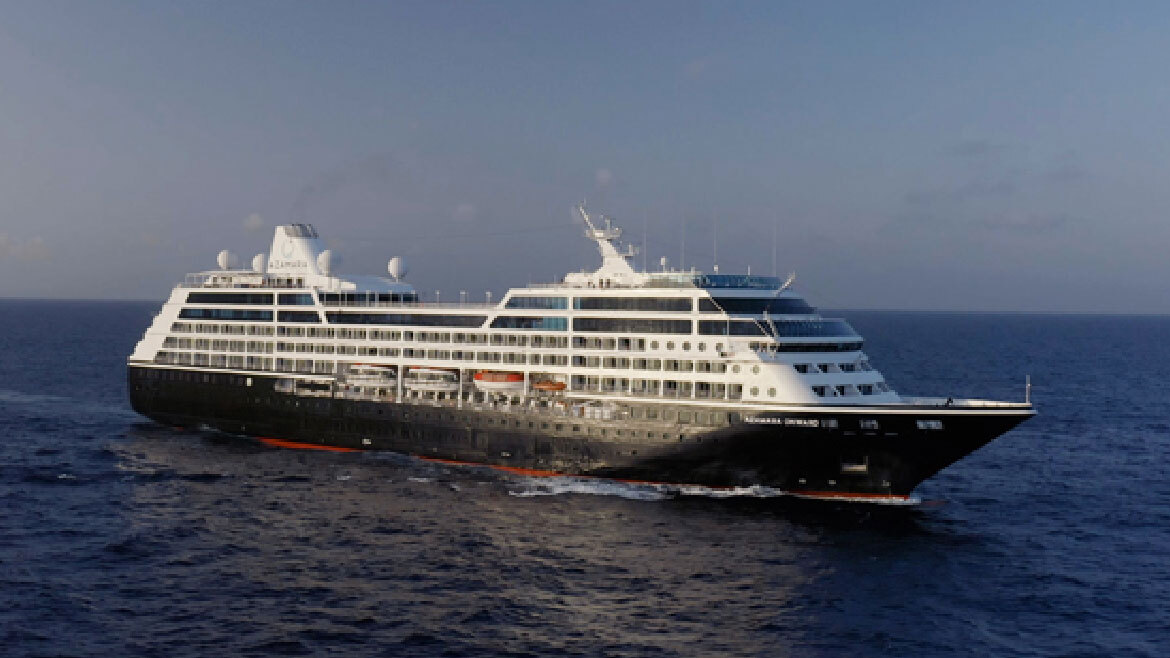Indonesia: Into the coral triangle
The water in Indonesia’s far-flung Raja Ampat archipelago is so clear you can often see all the way to the bottom, with colour the intensity of an aquamarine gemstone. Yet here it’s what you see when you’re beneath the surface of the ocean that makes it so enthralling.
Flamboyant sea fans and delicate sea feathers; undulating gardens of luminescent tipped staghorn — the coral comes in all shapes and colours. Some look as though they’ve been painted by Picasso or Miro; others like they were dreamt up by Yayoi Kusama. Each intricate network of these underwater gardens teems with marine life. Banded pipefish and giant morays hide in the crevices of the reef; schools of bannerfish, yellow snapper and fusiliers flitter past; and clownfish peer out of giant anemones. It’s often said that the planet’s most bizarre creatures inhabit the ocean; this archipelago is a haven for such marine life.
Raja Ampat stretches 200 miles from north to south, making up one part of the protected Bird’s Head Seascape of West Papua at the heart of the Coral Triangle. Known as the Amazon rainforest of the sea, this region is said to have the highest coral biodiversity in the world, boasting nutrient-rich coral flats, pinnacles, ridges and reef walls with eye-widening deep-blue-water drop offs. This bewitching marine playground is home to more than 1,400 species of reef fish, giant manta rays and four types of turtles, with cameo appearances from whales, dolphins and the elusive dugong.
More than 3,500 square miles of this marine environment is protected and the whole region is a sanctuary for rays and sharks. With such bountiful marine life, it’s no surprise that most people come to Raja Ampat to experience what lies in the waters. But this isn’t all the archipelago has to offer. Raja Ampat is just as beguiling on land.


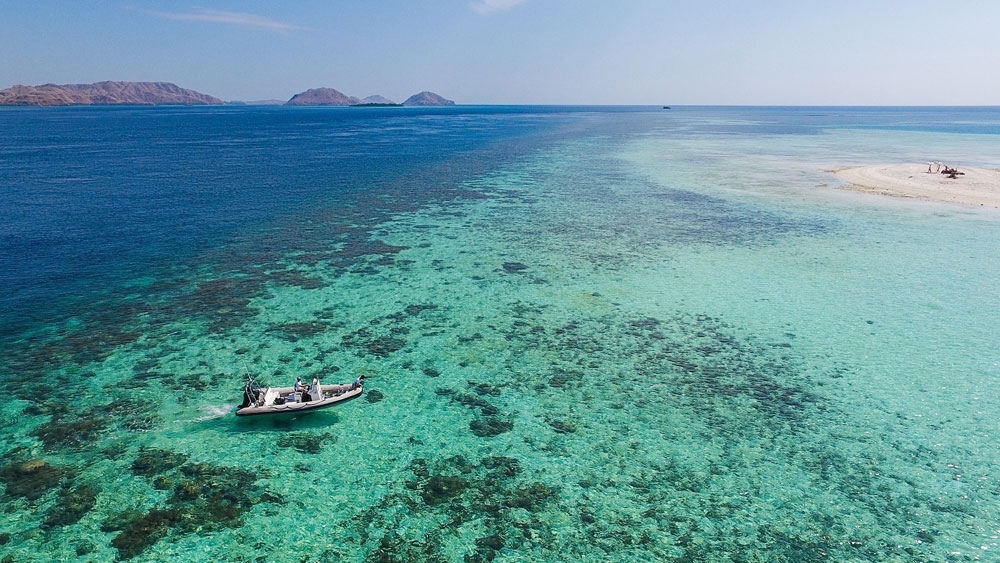
Nature’s playground
The main islands – Misool, Salawati, Batanta and Waigeo – make up Raja Ampat’s so-called ‘Four Kings’, but there are more than 1,500 islands, cays and shoals in all. Emerald forest clings to uninhabited white sand-fringed islands, and lush limestone karsts dot the vivid cerulean water. On a rainforest hike you could catch sight of the resident marsupial, the Waigeo spotted cuscus; cockatoos; the region’s unmistakeable hornbills, and Papua’s iconic bird of paradise, which 19th-century naturalist Alfred Russel Wallace described as “one of the most beautiful and most wonderful of living things”.
Raja Ampat is vast, and just a few guesthouses dot the archipelago. That being the case, most people travel around by liveaboard, and those who really want to travel in style opt for a phinisi, a traditional Indonesian sailing yacht.


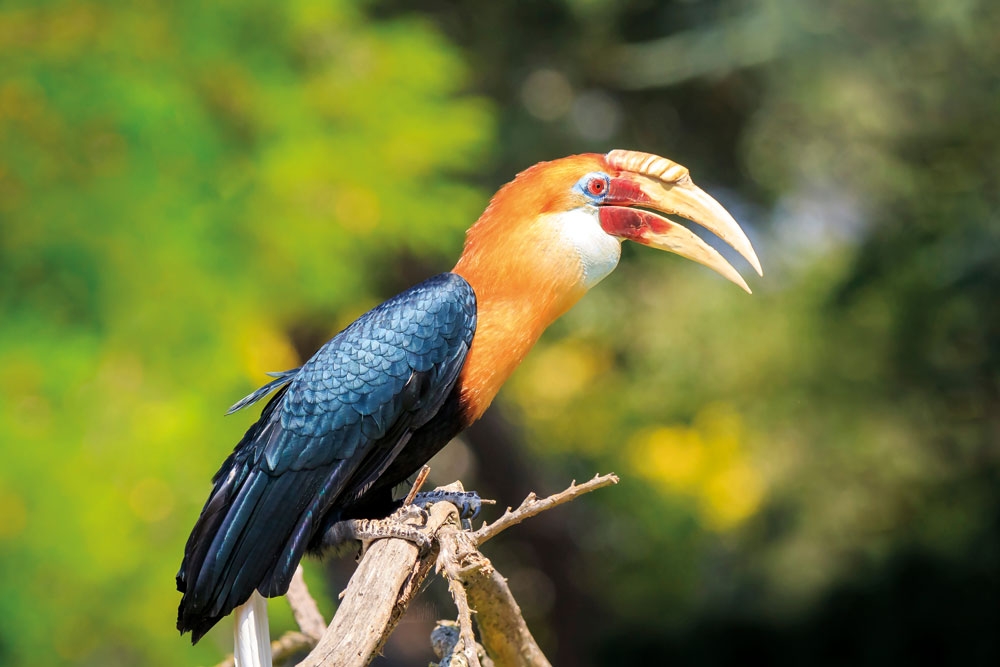
Celebrity lifestyle
Launched last September by the people behind chic Ibiza hideaway Atzaro, Prana by Atzaro is the latest and most luxurious of these boats to hoist its sails here. At 180ft, Prana is the biggest phinisi in the region, but with just nine cabins, including a spectacular master suite, the yacht accommodates up to 18 guests, plus an 18-strong crew. And just like its Ibizan counterpart, the boat already has a celebrity following, having recently hosted the Kardashian clan. The stylish teak and ironwood vessel features indoor and outdoor living and dining space, an Anne Semonin spa and a sports deck. The yacht’s two tenders zip you between islands, providing access to hidden lagoons and shallower plateaus of coral.
The phinisi’s captain, Andi, navigates a course through the jewel-like clusters of islands, chef Fauzi cooks up Indonesian-inspired fine dining cuisine, and bartenders Ardi and Jay whip up fresh coffees and signature cocktails. After a stint on land, the team is always there to welcome you back on board with a different blend of tropical juices, while spa therapists Cindy and Anna are on hand should you need a massage, reflexology or a facial. The cruise director, Cedric, maps out the trip, tailoring the plan to the interests of every guest and somehow managing to ensure everyone is deliriously happy, while co-ordinating what happens each day, acting as a dive instructor and accompanying guests on adventurous island hikes. A truly multi-skilled maestro.
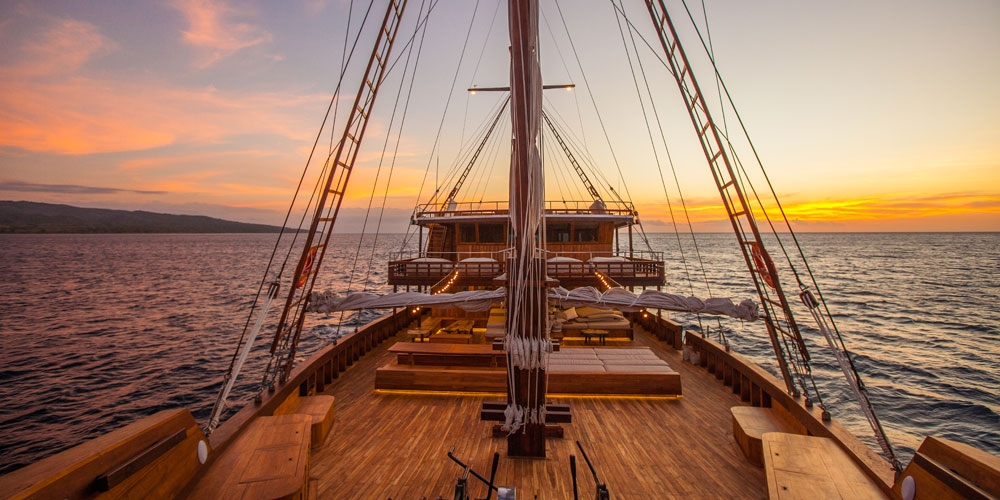

Setting sail
We begin our journey in Sorong, leaving the busy port for the tranquillity of the open sea, with nothing but sparsely populated islands and serene lagoons sheltered by limestone karsts. It takes a morning’s sailing northwest to reach the national park. Our first port of call is Mioskon, a bat-inhabited, heart-shaped island in the Dampier Strait with waters known for excellent diving owing to their abundance of unusual species like the bottom-dwelling wobbegong shark.
From here the journey takes us on an early-morning hike through rainforest. In the village of Saporkren, we trek to see the bird of paradise’s mating ritual at first light. We also visit the coastal community where huts line a jetty jutting out into the turquoise sea.
Over the next few days, we dive on the colourful reef and beneath the jetty of Yenbuba; scale the limestone slope of Wayag to see an iconic view of Raja Ampat; and stop by Aljui Bay for a guided tour of the Australian owned Atlas pearl farm. We dive down to the flourishing coral wall of Wofoh, drink fresh coconut water on a deserted white-sand beach, and return to the boat for an evening of tapas on the top deck followed by an open-air cinema under the stars. At one point we realise we’ve lost all concept of what day it is, only gauging time by each meal: was paddleboarding before or after second breakfast (yes, that’s a thing)
In the midst of all this, we cross the equator, from north to south, while sitting on the deck with our first drink of the evening. Cedric does a little jump as we reach the exact point of the equatorial line and we all cheer as we cross into the southern hemisphere.
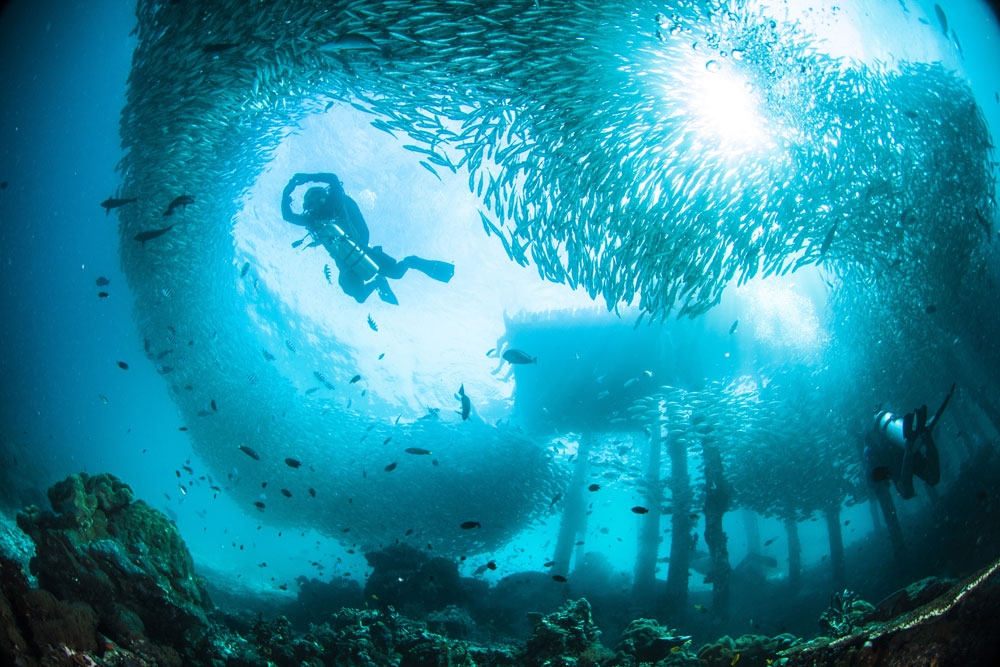

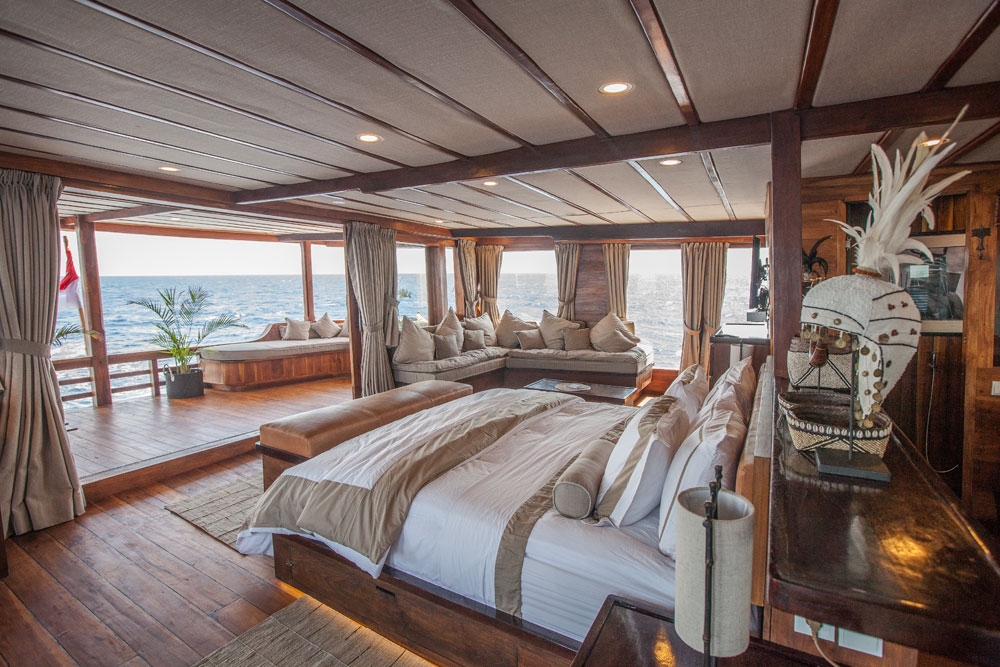
We pull anchor and sail to Piaynemo for the final day, hiking the steps to a wooden platform commanding incredible panoramic island views and swimming in a hidden lagoon. Here we dive in Melissa’s Garden, the most spectacular reef I’ve ever seen, where gentle current surges push you across the plateau of branching coral teeming with colourful fish as blacktip reef sharks glide by.
Arriving back in the throng of Sorong’s harbour marks our bittersweet farewell. We had travelled 250 nautical miles, but it was our journeys underwater that had had the biggest impact – leaving me head over heels with diving. I’d always appreciated the majesty of the sea but until my adventures in Indonesia I hadn’t truly felt the magic of being immersed in this underwater paradise.
And I’m not alone. Everyone who comes here seems to leave spellbound by this stretch of ocean. To sail through Raja Ampat – waking up each morning after cruising through the night in a remote cluster of deserted islands – is an overwhelming privilege. And this is never more apparent than when you’re sailing in the lap of luxury on a boat like Prana by Atzaro.
Book it: Prana by Atzaro sails through Raja Ampat from December to April and in the Komodo region from June to October, while sea crossings take in the Spice Islands in May and November. Charter rates range from $14,000 to $15,500 per night for Raja Ampat, $13,500 to $15,500 for the Komodo Islands and $12,500 to $13,500 for the Spice Islands. Individual suites can be booked, depending on availability.
Four marine life encounters
Marine mammals
Bottlenose and spinner dolphins can be seen from the bow of the boat on almost every trip, and there are occasional sightings of Bryde’s whales. Dugong (pictured) sightings are rare but one dugong that’s particularly friendly is known to gravitate towards the island of Batanta.
Manta rays and sharks
A designated ray and shark sanctuary, Raja Ampat offers frequent sightings of both. Swim with manta rays at dives sites like Manta Sandy and Manta Ridge, see reef sharks glide by while diving throughout the region, and spot wobbegong sharks move along the seabed.
Turtles
Four of the seven turtle species – hawksbill, green, leatherback and olive ridley – nest in the region. Nomadic by nature, turtles continually move around, so the turtles here are dispersed throughout the region but can often be spotted on snorkelling expeditions and dives.
Macro marine life
Raja Ampat is a hotbed of marine biodiversity, with a world record of 374 species recorded at Cape Kri alone in one single dive. Among these species is an abundance of macro marine life, including the tiniest of nudibranchs and pygmy seahorses. Kaleidoscope is one of the dive sites known for these tiny marine creatures.
